Japan
Wood Products Prices
Dollar Exchange Rates of 10th
Jan
2023
Japan Yen 132.25
Reports From Japan
No clear ditection on new recruitment
A recent survey commissioned by kyodonews showed
85% of companies were undecided on whether to hire
more students graduating university in 2024. Another 4%
indicated they are likely to cut back on hiring students.
Despite the rather pessimistic views the latest figures were
an improvement on the last survey a year ago. The survey
covered 7,200 private companies with five or more
employees between October and November 2022.
See: https://english.kyodonews.net/news/2023/01/22be9ab66cf8-
over-15-of-japan-firms-plan-to-hire-more-univ-graduates-in-
2024.html
Consumer sentiment remains low
The consumer confidence index in Japan increased in
December 2022 from November's low point for the year as
the government lifted all pandemic restrictions. However,
overall sentiment remains lower as price rises hurt
households and the eighth wave of the pandemic is yet to
reach its peak.
In December household sentiment strengthened for all
components with the willingness to buy durable goods
rising month on month for the first time in 2022.
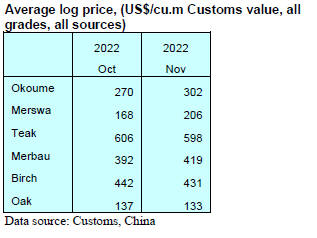
New power capacity based on wood pellets
Wood pellet demand in Asia is likely to diverge in 2023,
with Japanese consumption set to rise as new capacity is
brought on line, while South Korean demand could remain
stable.
Tight wood pellet supplies and firm demand are likely to
persist in the Japanese market through 2023 as more
biomass capacity is brought on line under the country's
FiT scheme. Vietnamese wood pellets that meet the
requirements of Japanese utilities under the country's feedin-
tariff (FiT) scheme rose to historical highs in 2022.
See:
https://www.argusmedia.com/en/news/2406850-viewpointasian-wood-pellet-demand-to-diverge
Yen likely to strengthen in 2023
There is a widespread view that the yen is set to strengthen
in 2023 reversing the plunge to a 32-year low against the
U.S. dollar in late 2022. Forecasts suggest the yen could
rise to 120 against the dollar from its current 133 yen. The
outlook contrasts with the currency's drop of more than
30% from around 115 yen at the beginning of 2022 to the
year's low near 152 yen in October.
The outlook for the yen exchange rate will be dictated by
the direction of Japan’s monetary policy which now seems
less predictable. The Bank of Japan Governor, Haruhiko
Kuroda, is likely to be replaced in April which is adding to
the uncertainty of policy direction.
See:
https://japantoday.com/category/business/Yen-set-forturnaround-in-2023-after-slide-to-32-year-low-vs-dollar
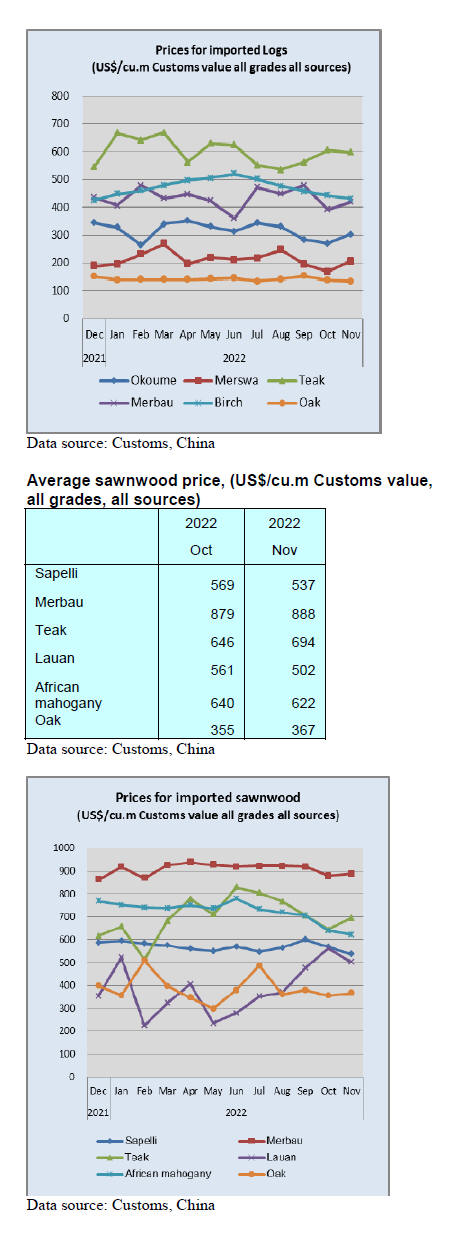
Attempts to lower population in Tokyo
The government has increased the payment being offered
to families who move out of greater Tokyo in an attempt
to reverse urban drift. The incentive, more than double the
amount previously offered, will be introduced in April.
The population in Tokyo declined for the first time in
2022 last year, due to pandemic related relocations spurred
by remote working but efforts continue to lower the
population density in Tokyo and encourage people to start
new lives in other parts of the country.
See:
https://asia.nikkei.com/Politics/Japan-to-raise-financialsupport-for-moving-out-of-Tokyo
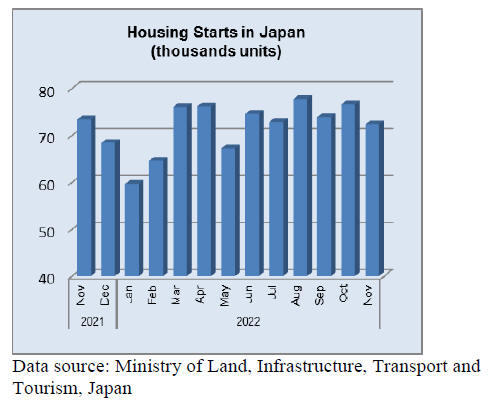
Assembled wooden flooring imports
In the first half of 2022 Japan’s imports of assembled
wooden flooring (HS441871-75) were at around the same
level as in the first half of 2021 but in May and June 2022
there was a surge in the value of imports which pushed up
total imports for the year to September by around 36%.
Throughout 2022 the top supplier of assembled wooden
floorin was China followed by Vietnam and Austria.
HS441875 was the main category of assembled flooring
imports in the first three quarters of 2022.
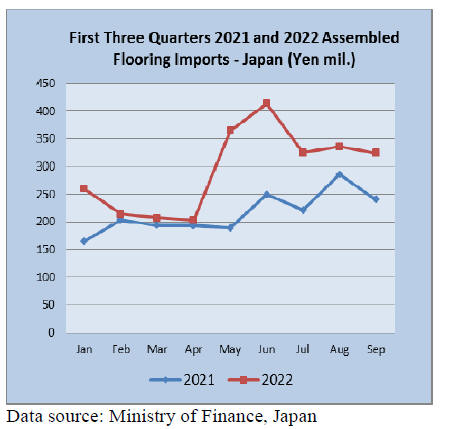
Plywood imports
The volume of Japan’s plywood imports in the first three
quarters of 2022 were around 35% up year on year.
Indonesia and Malaysia are the main suppliers of plywood
to Japan and together they accounted for over 75% of
the volume of imports between January and September
2022.
Compared to the volumes imported in the first three
months of 2021 shippers in Malaysia, Indonesia and
Vietnam saw gains in in the first three months of 2022.
However shipments from suppliers in China did not pick
up untila later in the year. More plywood manufactured
from domestic resources is on the market in Japan but the
supply of domestic panels fell for seven consecutive
months in 2022 because there was a surge in stocks.
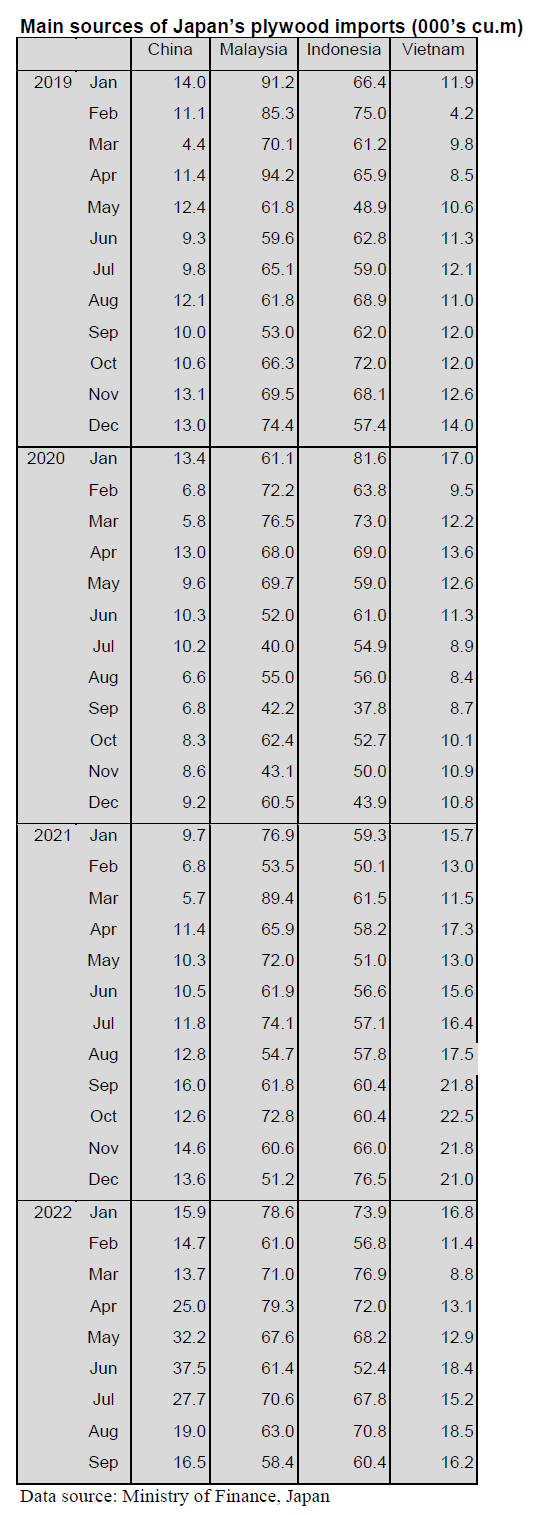

Trade news from the Japan Lumber Reports (JLR)
The Japan Lumber Reports (JLR), a subscription trade
journal published every two weeks in English, is
generously allowing the ITTO Tropical Timber Market
Report to reproduce news on the Japanese market
precisely as it appears in the JLR.
For the JLR report please see:
https://jfpj.jp/japan_lumber_reports/
Export logs for China, prices down
Cedar logs for China cost around US$110, C&F per cbm.
A peak of the prices was around US$160 in March, 2022.
It is about US$50, 31.3% lower than March, 2022. The
reasons are the dull world economy and low demand in
China. The prices of NZ logs declined to around US$120,
C&F per cbm.
The weak yen changed to the strong yen suddenly while
the export cost was low so the Japanese exporters did not
get profits. The Japanese exporters get cedar logs for
15,000 yen, delivered to a port per cbm and the prices
have not changed from September. A peak of freight was
in summer and the price was US$100,000 – 110,000 for
2,500 cbms size ship and the price is now US$60,000.
The export costs are now 25% lower than the export costs
in March because the yen became 150 yen from 115 yen
against the dollar. However, the yen is 135 yen recently.
The export costs are US$5 higher than before and are
US$110, C&F per cbm. It shows an over US$10 loss.
There is a slump in real estate business, a zero COVID-19
policy and low demand for logs in China. Therefore, it is
difficult to raise the log export prices for a while. If the
freight decreases by US$5, then the export costs would be
US$5 lower but still it does not make profit. Demand of
logs for wooden biomass in Japan is very active so the log
prices will not decrease.
Volume of exporting logs to China in 2021 was 1,218,775
cbms, 5.3% more than the result of 2020. It was straight
nine years increasing until last year. In this year, volume
of exporting logs during January to September is 823,445
cbms, 11.1% less than the same period in 2021.
The volume of 2022 will be lower than 2021’s result
certainly for the first time in ten years.
Japanese cedar logs are used for crating, public works and
fences for the United States in China. Once, the exporting
costs exceeded the NZ log prices and the freight to the
United States increased and it became below the cost after
the COVID-19 spread. Also, demand of logs for fences are
low. The container freight was US$20,000 for 40 feet
container, from Asia to North America and it is now
US$4,000. New housing starts in the United States are
sluggish and the North American markets are falling.
South Sea logs and lumber
Demand and supply of South Sea logs are balanced in
Japan. Shipbuilding and steel manufacturers got enough
South Sea lumber and so did lumber and plywood
manufacturers. It has been already a rainy season in South
Asia and there are fewer logs available. However, there
are no concerns about inventory because there is 2.45
months inventory in Japan.
The prices of South Sea and Chinese lumber are
decreasing in overseas and Japan. In China, the lunar New
Year holiday usually begins at the end of January but
some manufacturers will have the lunar New Year holiday
in the middle of January, 2023 because there is a policy
for zero-COVID in China. Indonesian manufacturers have
enough raw materials so they hope to get many orders
from Japan
Sodra to expand supplying to Japan
Sodra Wood, which is a Sweden’s largest forest owners
association and an international forest industry group, will
expand supplying lumber to Japan of 90,000 cbms as a
total volume in a year or two years. About 60,000 cbms of
90,000 cbms will be JAS (Japanese Agricultural
Standards) lumber.
The company got a certification of JAS for 2 x 4 lumber in
2020. Since the prices of Canadian SPF lumber are high,
Sodra expanded supplying lumber to Japan. In this year, a
supply of DIY will be 30,000 cbms and of JAS lumber
will be 30,000 cbms. Sodra is an international forest
industry group owned by 54,000 forest owners and
produces not only lumber but also pulps and biomass
fuels.
There are six lumber plants in Sweden and is one lumber
plant in Finland. The plants produce 2,200,000 cbms
lumber annually. 70% of the annual product is whitewood
lumber and 30% of the annual product is redwood lumber.
The products are all planed lumber. The company supplies
30% lumber in Sweden, 30% in the United Kingdom, the
United States, China, Japan and other areas in Europe.
For Japan, Monsteras plant produces DIY lumber and
Varo plant produces JAS lumber. Varo plant is available
to produce 700,000 cbms JAS lumber in a year and to
consume afforested trees from FSC (Forest Stewardship
Council) and PEFC (Programme for the Endorsement of
Forest Certification Schemes) so a yield rate for lumber is
very high.
The sizes of JAS lumber for 2 x 4 and 2 x 6 are 6 –
16
feet. The company plans to produce 300mm genban made
of whitewood and long or wide lumber as the market in
Japan expands. The prices of logs and electricity are
extremely high in Europe but not in Scandinavia.
Mokko Land Co., Ltd. in Yamanashi prefecture, Japan,
which imports exterior lumber form overseas, is now in
charge of doing business for Sodra.
The vice president of Mokko Land says that there are not
many enquires for DIY recently because high demand
during COVID-19 is over now. There is a possibility of
expanding supply of JAS lumber for 2 x 4 because the
market size is over 800,000 cbms of 2 x 4 lumber
annually. Mokko Land tries to import 5,000 cbms JAS
lumber in a month and will expand importing 60,000 cbms
of JAS lumber annually
|